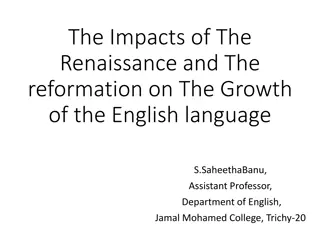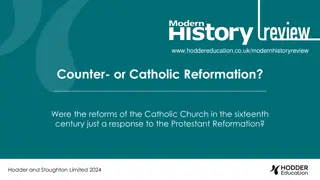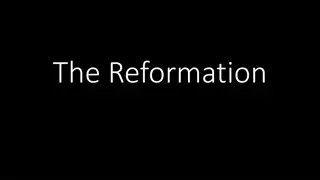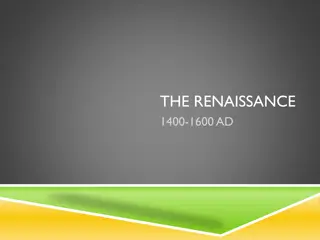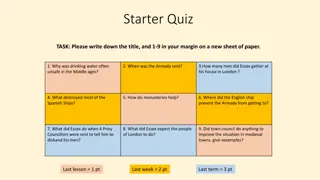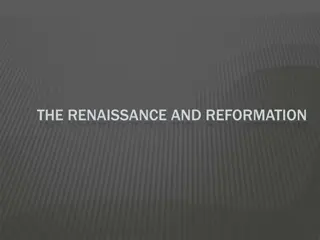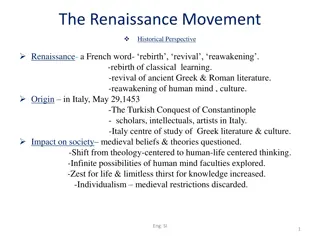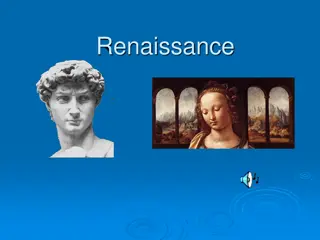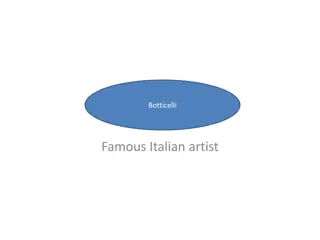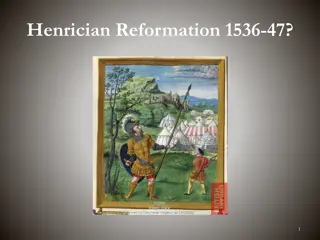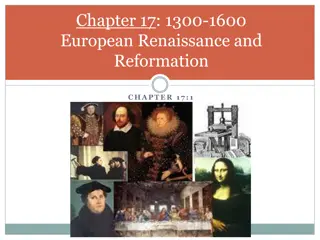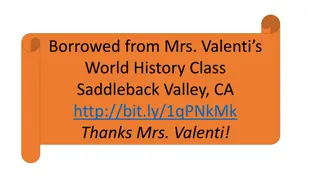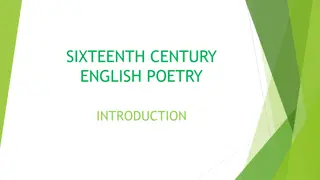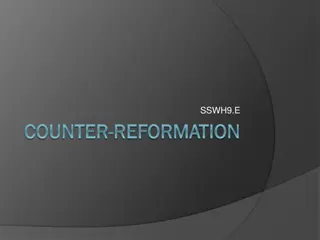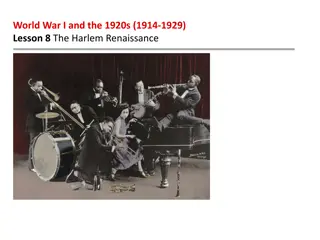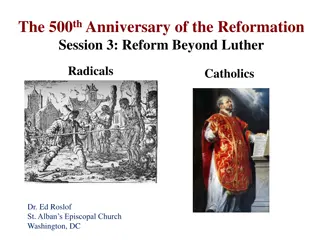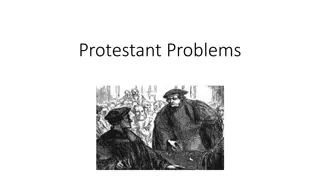
Renaissance and Reformation: Cultural Transformations in Europe
Explore the Renaissance and Reformation periods, characterized by a revival of classical works, humanism, and societal changes in Europe. From the rise of the Italian Renaissance and city-states to prominent figures like Petrarch, Brunelleschi, and Leonardo da Vinci, delve into the art, literature, and societal shifts that shaped this dynamic era.
Download Presentation

Please find below an Image/Link to download the presentation.
The content on the website is provided AS IS for your information and personal use only. It may not be sold, licensed, or shared on other websites without obtaining consent from the author. If you encounter any issues during the download, it is possible that the publisher has removed the file from their server.
You are allowed to download the files provided on this website for personal or commercial use, subject to the condition that they are used lawfully. All files are the property of their respective owners.
The content on the website is provided AS IS for your information and personal use only. It may not be sold, licensed, or shared on other websites without obtaining consent from the author.
E N D
Presentation Transcript
The Renaissance & The Reformation
The Renaissance 1300-1600 Rebirth Rediscovery of classical works in Arab libraries Rising from the ashes of the Black Death Humanism Study of classical antiquity Engagement of civic life Educated population Achieving your best
Continued Humanities Study of human society & culture Languages, literature, philosophy, history Geography, law, politics, religions, & art Petrarch, 1304-1374 Founder of Humanism Writer and scholar of ancient texts Works to compose classical libraries
The Italian Renaissance Surrounded by the ancient world Architecture, statuary, frescos, mosaics, literature Rise of the Merchant Class Economic connections with the East and Northern Europe Patronage of the arts New families rise to prominence, compete with noble class The signore or lord becomes leading position Italian city states
Italian City-States & Rulers Venice The Doge Life-time elected position as magistrate The Papal States Rome, base of Papal power Florence The Medici family Banking Milan The Sforza family History of Tuscan military power
Brunelleschi & the Duomo 1377-1446 Founding Father of the Renaissance Friend of sculptor, Donatello Commissioned to work on the Santa Maria del Fiore Duomo Buttresses forbidden, internal supports needed No plans survive Use of linear perspective Vanishing point Artistic standard thru the 19thcentury
Leonardo da Vinci 1452-1519 True Renaissance Man Painter, sculptor, inventor, scientist Technological ingenuity Mona Lisa and The Last Supper Born out of wedlock in humble beginnings Trains under Verrocchio Still holds prominent place in Western art Salvator Mundi, $450.3 million November 2017
Michelangelo 1475-1564 Sculptor, painter, architect, & poet Connected to the Medici family Minor political family Raised by nanny and her stone mason husband Developed love for stone carving Pieta & The David Commissioned by Pope Julius II to paint the Sistine Chapel 1508-1512 Again called on by the Vatican, 1546, as architect of St. Peter s Basilica
Raphael 1483-1520 Artistic upbringing Father, Giovanni Santi, court painter for the Duke of Urbino Rival of Michelangelo Establishes artisan workshop 50 pupils and assistance Disbanded after the sacking of Rome in 1517 Knighted within the Papal State Groom of the Chamber Rises again to prominence during the 18th& 19thCenturies
Machiavelli 1469-1527 Diplomat, politician, historian, & philosopher Senior official in Florence Author of The Prince Political Science beginnings Dealings of the State How the State should behave Dishonesty & killing of innocence, normal and effective Machiavellianism Negative Tyrannical, Unscrupulous
Castiglione 1478-1529 Courtier, diplomat, soldier, & author Represented Gonzaga family Ruling family of Mantua Author of The Courtier Gonzaga court ruled by Elisabetta Gonzaga & Emilia Pia Rules of etiquette & morality The Gentleman & Courtier should be, Trained in the classics A man-at-arms, horseman, & noble Protector of women
Northern Renaissance Dawns later than its southern counterpart Influenced by war and reform Flanders French held territory, Dutch speaking Ghent, Bruges, & Antwerp Wool industry Develops a sophisticated culture of art & architecture Rival of Northern Italy
Jan Van Eyck 1390/1395-1441 Worked closely with Dutch rulers The Hague Paid well, financially stable Est. workshop Widow pensioned Secular & Religious works Revolutionary in design Small, key background details Blending of the real and the symbolic
Pieter Bruegel 1525/1530-1565 Dutch Golden Age Master Printer & Painter Painting a later pursuit No portraiture Subjects of the everyday Peasant Bruegel Peasant scenes, landscapes, & months of the year Medieval in subject yet modern in appearance
Albrecht Durer 1471-1528 German Painter, printmaker, engraver, author Reputation for woodcut prints Mathematics, perspective, & ideal proportions Commissioned by Holy Roman Emperor Maximilan I Travels to Italy Communicates with da Vinci & Raphael Four Books of Measurement- Geometry Four Books on Human Proportion
Erasmus 1466-1536 Christian humanist Human dignity, individual freedom, and happiness Compatible with the teachings of Christ Produced Latin & Greek translations of the Bible Helped raise questions which lead to the Reformations Called for reform within the Catholic Church Maintained authority of the Pope Continued practicing Author of the Via Media Middle way between the ideas of freewill and predestination
Thomas More 1478-1535 English humanist Lawyer, philosopher, author, statesman Councilor to Henry VIII Utopia New World society Equality of service, limitations on material wealth, tolerance, simplicity Opposed Protestant Reformation Executed during Henry s reign
Francois Rabelais 1483/1494-1553 French humanist Writer, physician, monk, & Greek scholar Works described as Fantasy, satire, grotesque, & bawdy Gargantua & Pantagruel Adventures of a father/son giant pair Father of modern European writing
Shakespeare 1564-1616 Stratford-upon-Avon, England Poet, playwright, & actor 39 plays & 154 sonnets Tragedies, comedies, & histories Romeo & Juliet, Much Ado About Nothing, & Richard III Co-founder of the Lord Chamberlains Men company Fallen in and out of literary favor Preeminent Dramatist
Johann Gutenberg 1400-1468 German Engraver, inventor, & printer Movable type Mass production Oil based inks Wooden printing press Appealed to emerging Middle Class 1455- Bible printing begins 3 years salary to purchase 48 survive today
Criticism of the Church Papal competition for worldly power Wars, invasions, territorial gains/loses Plotting against secular rulers Lavish life style and construction projects Increase fees on marriages & baptisms Indulgences Lessened a person s time spent in purgatory Eventually up for sale Call for a simpler way Christian humanism Bible study and prayer
John Wycliffe 1320 s-1384 English philosopher Attacked privileged status of the clergy Promoted the translation of the Bible Wycliffe s Bible Views & Supports Predestination, Iconoclasm, & Separation of Church & State Against veneration of the saints, sacraments, and the papacy
Martin Luther 1483-1546 Theologian, composer, priest, & professor Disputed the selling of indulgences Academic discussion Ninety-five Theses, 1517 Castle Church of Wittenburg, Germany Charles V Holy Roman Emperor Calls the Diet of Worms Organized meeting of German princes Luther refuses to renounce writings Deemed an outlaw
Continued 1521, Excommunicated by Pope Leo X Married a former nun, Katharina von Bora Marriage produces six children Translated Bible into German, hymn writer Religiously intolerant Jews, Catholics, Anabaptists, nontrinitarian Christians Reforms cause division in Germanic principalities Peace of Augsburg, 1555 Local princes could determine protestant or Catholic beliefs Ease of immigration for dissenters
John Calvin 1509-1564 French theologian, pastor, and reformer 1530, Breaks from the Catholic Church Violence against protestant groups Flees to Geneva, Switzerland Begins preaching, opposed by city council Expelled and leaves for Strasburg 1541, invited back to Geneva Growing refugee population supportive of reforms Gains prominent control of the city
Catholicism Lutheranism Calvinism Salvation Through faith and good works Achieved through faith God alone predetermines who will be saved Sacraments Priests preform 7 sacraments or rituals Accepts some of the sacraments but rejects others because rituals cannot erase sin only God Can. Accepts some of the sacraments but rejects others because rituals cannot erase sin only God Can. Head of the Church The Pope Elected councils Council of elders Importance of the Bible Bible is one source of truth; Church tradition is another Bible alone is source of truth Bible alone is source of truth How Belief is Revealed Priests interpret the Bible and Church teachings for the people People read and interpret the Bible for themselves People read and interpret the Bible for themselves
Anabaptists Begin emerging in 1525 German & Dutch speaking territories Name means to baptize again Broke from Catholic and reformer belief in infant baptism Candidates for baptism should be able to make their decision Invested in the leadership of the lay person Swiss Brethren under Huldyrch Zwingli Schlietheim Articles of 1527, communal and religious standards Persecuted by Catholics & Protestants Executed, exiled, converted, or Nicomedian in nature
The Rise of the Church of England 1530 s, Henry VIII wants a divorce from Katherine of Aragon Pope Clement VII denies request Henry breaks from the Catholic Church Passage of the Act of Supremacy English monarch the head of the Church Falls in and out of favor until the reign of Elizabeth I Book of Common Prayer, 1552 & 1559 39 Articles of Religions, 1563 Established as being both Catholic & Protestant
War of the Roses 1455-1487 Response to financial and feudal instability after the Hundred Years War English civil war for the claim of the throne Two lines of the Plantagenet family Lancaster (Red Rose) York (White Rose) Eventual destruction of the male lines of both families 1485, Battle of Bosworth Fields Lancaster victory of sorts Henry Tudor, distant relative Henry VII of England marries Elizabeth of York
Henry VIII 1491-1547 Succeed brother Arthur at 17 Description Young: Attractive, educated, accomplished Old: Lustful, egotistical, harsh, & insane Six wives, three legitimate children Advised by Thomas More & Cardinal Wolsey Wolsey made Cardinal & Lord Chancellor of England in 1515
Continue Big Spender Costly wars on the continent Dissolution of the Monasteries hoped to aid Nearly always on the verge of financial ruin English reformer Divine Rights of Kings Church of England Changes to the English Constitution Expansion of royal power Suffers in later years Immense weight Open sours
Katherine of Aragon 1485-1536 Daughter of Ferdinand & Isabella of Spain Aunt of Charles V, Holy Roman Empire First marriage to Henry s brother Arthur Marries Henry in 1509 1516, delivers first surviving child, Mary The King s Great Matter Leviticus 20:21 Thomas Cranmer helps build the case Appealed for papal involvement, annulment denied Wolsey blamed Exiled and separated from Mary Dies of probable cancer on the day Henry s new wife, Anne, miscarries a son
Anne Boleyn 1501-1536 Educated abroad Returns to England as Katharine of Aragon s lady-in-waiting Catches Henry s eye Replaced her sister Mary January 1533, secret wedding to Henry September 7, 1533, birth of daughter Elizabeth Protestant Unable to produce a male heir Charged with trumped up charges of incest and adultery Executed
Jane Seymour 1508-1537 Lady-in-waiting to Anne Boleyn Marries Henry one day after Anne s execution Conservative, religiously & politically Compassionate towards the status of Katherine & Mary Publically popular October 12, 1537, Edward born Long, hard labor Dies October 24 Henry publically mourns Jane s death Henry buried beside her
Anne of Cleves 1515-1557 German noble Limited education, but described as being pleasant She and her sister, Amalia, courted by Henry from afar Hans Holbein commissioned to paint their likeness Begins journey to Dover, England Meets Henry on New Year s Day 1540 Meeting doesn t go well Married January 6 and divorced July 9 of 1540 Granted lands and title of the King s beloved sister Becomes a part of the royal family Dies of cancer July 16, 1557
Katherine Howard 1523-1542 Aristocratic, cousin of Anne Boleyn Reputation of be flirty & vivacious Worked in the household of Anne of Cleves Catches Henry s eye Marries the King July 28, 1540 Aging Henry comes more violent and suffers from extreme pain Alleged meetings with Thomas Culpeper with the aid of June Boleyn Cranmer pushes for arrest Imprisoned in the Tower of London Beheaded
Katherine Parr 1512-1548 Henry was the 3rdof her 4 husbands Plays nurse to Henry Close relationships with Henry s children Sees the restoration of the princesses Mary & Elizabeth Henry dies on January 28, 1547 Katherine marries Thomas Seymour Brother of Jane Gives birth to a daughter but dies in September of 1548
Edward VI 1537-1553 First English monarch raised fully protestant Succeeds father in 1547 Uncle, Edward Seymour, becomes protector Introduces furthered protestant reformers Catholic uprisings in Devon and Cornwall Uncle beheaded and John Dudley takes control of Edward Anti-Catholic endeavors Thomas Cranmer continues anti-Catholic rhetoric Marriage partnered search begins in earnest 1552, Edward contracts measles and smallpox Dies of possible tuberculosis on July 6, 1553
Jane Grey 1537-1554 Great-niece of Henry the VIII Maternal grandmother, Mary Tutor The Dudley Plot Forced to marry Dudley s son, Guildford Maneuvered into being the next heir to Edward Proclaimed queen but refused her husband the title of king July 9, 1553 The Nine Day Queen Unpopular move crowning Jane, people favored Mary Tutor Mary begins marching toward London backed by an army Jane s supporters ebbed away Father-in-Law executed Jane and Guildford imprisoned then beheaded
Mary Tudor 1516-1558 Miserable life Devoted Catholic Family tension July 19, 1553, declared Queen 1554, Marries Philip II of Spain Unpopular Spanish match Hopes to use marriage to reestablish Catholic beliefs 1555, Marian persecution begins 300 protestant martyrs Bloody Mary Unhappy ending Loss of Calais in the war with France Phantom pregnancy, and abandoned by her husband Dies in a air of grief
Elizabeth 1533-1603 Disappointment to her father Act of Succession of 1544 Mary would follow Edward, then Elizabeth Exposed to protestant teaching but lacked enthusiasm Religious pragmatist Smooth transition to power in 1558 The marriage question? Courted by members of court and men from abroad Never takes a husband
Continued Via Media 1559, The Act of Uniformity 1570, Pope Pius V grants permission to overthrow Elizabeth How do you solve a problem like Mary Stewart Mary Stewart, Catholic choice to rule England Granddaughter of Henry VII Pushed off Scottish throne by subjects, seeks aid from Elizabeth 1586 Mary s involvement in the Babington Plot discovered Tried and found guilty but, had to wait for Elizabeth s decision Three months later Mary executed Elizabeth displays grief, fury, and regret
Council of Trent 1545, convened by Pope Paul III Off and on meeting for 20 years, prompted by growing reform Reaffirmed challenged Catholic beliefs Salvation by faith and works Bible and church teachings source of religious truths Makes steps to end abuses Penalties for worldliness and corruption Establishment of schools for an educated clergy Seen as a challenge to the protestant reformers
The Inquisition Begins in the 12thcentury Grows in response to the Protestant Reformation Targeting of religious minorities and outcasts Connections of religious & secular courts Testimony, torture, penance, & execution Creation of The Index of Forbidden Books Targets writings of Luther, Calvin, & Petrarch Estimates of 44,674 cases Over 800 executions Over 700 executions in effigy

